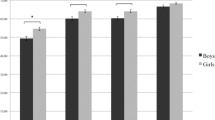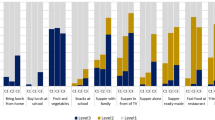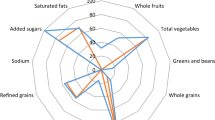Abstract
Background/Objectives:
Unhealthy eating behaviours may contribute to the rising prevalence of childhood obesity in Canada. The purpose of this study was to describe family dinner frequency (FDF) and its associations with overall diet quality.
Subjects/Methods:
The sample included grades six (n=372), seven (n=429) and eight (n=487) students from Southern Ontario. Data were collected with the Food Behaviour Questionnaire, including a single 24-h dietary recall and questions about individual meals. Diet quality was calculated using the Healthy Eating Index-C (HEI-C), which is a recently modified diet quality index.
Results:
The majority of participants (65%) reported frequent family dinner meals (6–7 days/week versus 20% on 3–5 days/week and 15% on 0–2 days/week). Diet quality scores were higher among participants reporting 6–7 dinners/week (HEI-C=66.2 versus 62.1 and 62.8 for 0–2 and 3–5 days/week, respectively, P<0.001). Adjusted models reported that diet quality scores were also associated with whom participants consumed breakfast (P<0.001), lunch (P<0.001) and dinner (P<0.001), yet they were most strongly associated (negatively) with participants who skipped the meal altogether.
Conclusions:
Increased family dinner meals were positively associated with daily diet quality and negatively associated with breakfast and lunch skipping. Promoting family dinner meals in healthy living intervention strategies is advised.
This is a preview of subscription content, access via your institution
Access options
Subscribe to this journal
Receive 12 print issues and online access
$259.00 per year
only $21.58 per issue
Buy this article
- Purchase on Springer Link
- Instant access to full article PDF
Prices may be subject to local taxes which are calculated during checkout
Similar content being viewed by others
References
Bandini LG, Schoeller DA, Cyr HN, Dietz WH (1990). Validity of reported energy intake in obese and nonobese adolescents. Am J Clin Nutr 52, 421–425.
Baranowski T, Domel SB (1994). A cognitive model of children's reporting of food intake. Am J Clin Nutr 59, 212S–217S.
Bar-Or O, Foreyt J, Bouchard C, Brownell KD, Dietz WH, Ravussin E et al. (1998). Physical activity, genetic, and nutritional considerations in childhood weight management. Med Sci Sports Exerc 30, 2–10.
Black AE (2000). Critical evaluation of energy intake using the Goldberg cut-off for energy intake: basal metabolic rate. A practical guide to its calculation, use and limitations. Int J Obes Relat Metab Disord 24, 1119–1130.
Briefel RR, Sempos CT, McDowell MA, Chien S, Alaimo K (1997). Dietary methods research in the third National Health and Nutrition Examination Survey: underreporting of energy intake. Am J Clin Nutr 65, 1203S–1209S.
Canadian Fitness and Lifestyle Research Institute (2009). Physical Activity Monitor. http://www.cflri.ca/eng/statistics/surveys/documents/CANPLAY2009_Bulletin01_PA_levelsEN.pdf.
Champagne CM, DeLany JP, Harsha DW, Bray GA (1996). Underreporting of energy intake in biracial children is verified by doubly labeled water. J Am Diet Assoc 96, 707–709.
Cohen B, Evers S, Manske S, Bercovitz K, Edward WH (2003). Smoking, physical activity and breakfast consumption among secondary school students in a southwestern Ontario community. Can J Public Health 94, 41–44.
Cole TJ, Bellizzi MC, Flegal KM, Dietz WH (2000). Establishing a standard definition for child overweight and obesity worldwide: international survey. BMJ 320, 1240–1243.
Evers S, Taylor J, Manske S, Midgett C (2001). Eating and smoking behaviours of school children in southwestern Ontario and Charlottetown, PEI. Can J Public Health 92, 433–436.
Feldman S, Eisenberg ME, Neumark-Sztainer D, Story M (2007). Associations between watching TV during family meals and dietary intake among adolescents. J Nutr Educ Behav 39, 257–263.
Fitzpatrick E, Edmunds LS, Dennison BA (2007). Positive effects of family dinner are undone by television viewing. J Am Diet Assoc 107, 666–671.
Fulkerson JA, Story M, Mellin A, Leffert N, Neumark-Sztainer D, French SA (2006). Family dinner meal frequency and adolescent development: relationships with developmental assets and high-risk behaviors. J Adolesc Health 39, 337–345.
Gable S, Chang Y, Krull JL (2007). Television watching and frequency of family meals are predictive of overweight onset and persistence in a national sample of school-aged children. J Am Diet Assoc 107, 53–61.
Garriguet D (2004). Overview of children's eating habits (Statistics Canada). http://www.statcan.ca/english/research/82-620-MIE/82-620-MIE2006002.pdf.
Gillman MW, Rifas-Shiman SL, Frazier AL, Rockett HR, Camargo Jr CA, Field AE . et al. (2000). Family dinner and diet quality among older children and adolescents. Arch Fam Med 9, 235–240.
Glanville NT, McIntyre L (2006). Diet quality of Atlantic families headed by single mothers. Can J Diet Pract Res 67, 28–35.
Hanning RM, Royall D, Toews JE, Blashill L, Wegener J, Driezen P (2009). Validation of the web-based food behaviour questionnaire with grade six to eight Ontario students. Can J Diet Pract Res 70, 172–178.
Hanning RM, Woodruff SJ, Lambraki I, Jessup L, Driezen P, Murphy C (2007). Nutrient intakes and food consumption patterns among Ontario students in grades six, seven, and eight. Can J Public Health 98, 12–16.
Health Canada. Canadian Nutrient File 2001b. http://www.hc-sc.gc.ca/fn-an/nutrition/fiche-nutri-data/cnf_aboutus-aproposdenous_fcen-eng.php.
Institute of Medicine of the National Academies (2005). Dietary Reference Intakes: Energy, Carbohydrate, Fiber, Fat, Fatty Acids, Cholesterol, Protein, and Amino Acids (Macronutrients). The National Academies Press: Washington, DC.
Jones JM, Bennett S, Olmsted MP, Lawson ML, Rodin G (2001). Disordered eating attitudes and behaviours in teenaged girls: a school-based study. Can Med Assoc J 165, 547–552.
Kant AK (1996). Indexes of overall diet quality: a review. J Am Diet Assoc 96, 785–791.
Kennedy ET, Ohls J, Carlson S, Fleming K (1995). The healthy eating index: design and applications. J Am Diet Assoc 95, 1103–1108.
Kuczmarski RJ, Ogden CL, Grummer-Strawn LM, Flegal KM, Guo SS, Wei R et al. (2007). CDC growth charts: United States. Adv Data 11, 1–27.
Livingstone MB, Prentice AM, Coward WA, Strain JJ, Black AE, Davies PS et al. (1992). Validation of estimates of energy intake by weighed dietary record and diet history in children and adolescents. Am J Clin Nutr 56, 29–35.
Livingstone MB, Robson PJ (2000). Measurement of dietary intake in children. Proc Nutr Soc 59, 279–293.
McVey G, Tweed S, Blackmore E (2001). Dieting among preadolescent and young adolescent females. Can Med Assoc J 170, 1559–1561.
Ministry of Health and Long Term Care (2004). Chief Medical Officer of Health Report. Healthy Weights Healthy Lives. http://www.health.gov.on.ca/english/public/pub/ministry_reports/cmoh04_report/cmoh_04.html.
Neumark-Sztainer D, Hannan PJ, Story M, Croll J, Perry C (2003a). Family meal patterns: associations with sociodemographic characteristics and improved dietary intake among adolescents. J Am Diet Assoc 103, 317–322.
Neumark-Sztainer D, Wall MM, Story M, Perry CL (2003b). Correlates of unhealthy weight-control behaviors among adolescents: implications for prevention programs. Health Psychol 22, 88–98.
Sen B (2006). Frequency of family dinner and adolescent body weight status: evidence from the national longitudinal survey of youth, 1997. Obesity (Silver Spring) 14, 2266–2276.
Shields M (2005). Overweight Canadian children and adolescents (Statistics Canada). http://www.statcan.ca/english/research/82-620-MIE/82-620-MIE2005001.htm.
Vance VA, Woodruff SJ, McCargar LJ, Husted J, Hanning RM (2008). Self-reported dietary energy intake of normal weight, overweight, and obese adolescents. Public Health Nutr 12, 222–227.
Veugelers PJ, Fitzgerald AL (2005). Effectiveness of school programs in preventing childhood obesity: a multilevel comparison. Am J Public Health 95, 432–435.
Veugelers PJ, Fitzgerald AL, Johnston E (2005). Dietary intake and risk factors for poor diet quality among children in Nova Scotia. Can J Public Health 96, 212–216.
Videon TM, Manning CK (2003). Influences on adolescent eating patterns: the importance of family meals. J Adolesc Health 32, 365–373.
Woodruff SJ, Hanning RM (2008). A review of family meal influence on dietary quality of adolescents. Can J Diet Pract Res 69, 14–22.
Woodruff SJ, Hanning RM, Lambraki I, Storey K, McCargar L (2008). Healthy Eating Index-C is compromised among adolescents with body weight concerns, weight loss dieting, and meal skipping. Body Image 5, 404–408.
World Health Organization Technical Report Series (1985). Energy and protein requirements. Report of a joint FAO/WHO/UNU expert consultation 724, 1–206.
Acknowledgements
This research study was funded by the Canadian Institutes of Health Research, Institute of Population and Public Health (Ottawa, ON). SJ Woodruff was funded by a Doctoral Student Award in Nutrition Education and Communication from the Danone Institute of Canada.
Author information
Authors and Affiliations
Corresponding author
Ethics declarations
Competing interests
The authors declare no conflict of interest.
Additional information
Contributors: SJW wrote this manuscript as part of her PhD thesis. RHM was SJW's thesis supervisor and KSB served as a committee member. KM collected data within each school.
Rights and permissions
About this article
Cite this article
Woodruff, S., Hanning, R., McGoldrick, K. et al. Healthy eating index-C is positively associated with family dinner frequency among students in grades 6–8 from Southern Ontario, Canada. Eur J Clin Nutr 64, 454–460 (2010). https://doi.org/10.1038/ejcn.2010.14
Received:
Revised:
Accepted:
Published:
Issue Date:
DOI: https://doi.org/10.1038/ejcn.2010.14
Keywords
This article is cited by
-
Food labour, consumption hierarchies, and diet decision-making in Sri Lankan households: a qualitative study
BMC Nutrition (2020)
-
Child diet and health outcomes of the simple suppers program: a 10-week, 2-group quasi-experimental family meals trial
BMC Public Health (2019)
-
Measures of low food variety and poor dietary quality in a cross-sectional study of London school children
European Journal of Clinical Nutrition (2018)
-
Methods and design of a 10-week multi-component family meals intervention: a two group quasi-experimental effectiveness trial
BMC Public Health (2017)
-
Associations between company at dinner and daily diet quality in Dutch men and women from the NQplus study
European Journal of Clinical Nutrition (2016)



